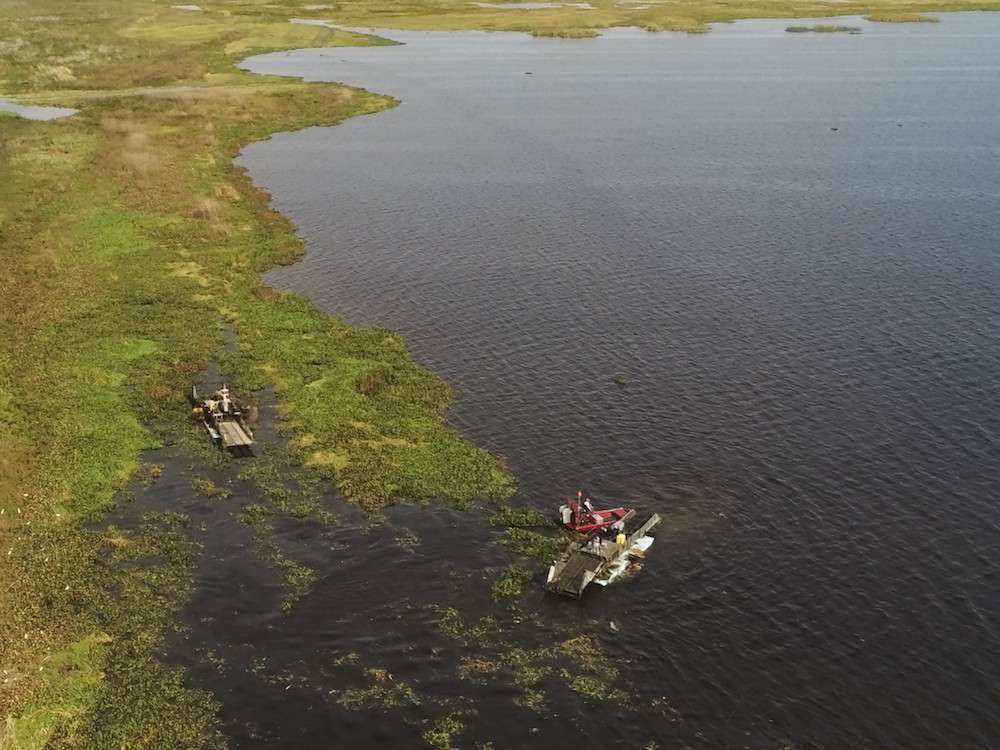
Florida is arguably the bass fishing capital of the world, but the Sunshine State also claims the unwanted designation as home to the most invasive species. Invaders like pythons and lionfish are universally regarded as having negative consequences on the environment, but the story with freshwater invasive aquatic plants like hydrilla and water hyacinth is less well known and more complex.
Invasive plants are defined as plants not native to Florida that are known to cause environmental and economic harm. Because they grow much faster than native plants, they require management actions to prevent negative impacts. Managing non-native invasives is critical for providing quality habitat for fish and wildlife, as well as recreational opportunities for the public. Also, if invasive plants are not managed, they can outcompete native plants and create threats to human health and safety by blocking navigation and causing flooding issues.
While the Florida Legislature designates the Florida Fish and Wildlife Conservation Commission (FWC) as the lead agency to combat nonnative species in the state, the FWC works with many partners including the U.S. Army Corps of Engineers, water management districts and local governments. When managing invasive plants, it is important to balance the needs of stakeholder groups who use Florida’s freshwater resources. It can be challenging to manage high-quality fish and wildlife habitat while balancing the needs of stakeholders using these waterbodies. However, the FWC is committed to doing just that.
The FWC receives feedback from Florida residents and visitors regarding its Aquatic Plant Management Program. Some people think the agency needs to manage systems more aggressively while others would prefer less management. The FWC prides itself in working with the public to arrive at solutions together. So, in an effort to address stakeholder concerns, the FWC spent the past year incorporating a variety of enhancements into the Invasive Plant Management Program.
One of the first steps FWC staff took was to form a Technical Assistance Group, or TAG, consisting of staff, partners and stakeholders. Nearly 30 individuals representing recreational and professional anglers, waterfowl hunters, water-related businesses including restaurants and marinas, recreational groups, conservation organizations, local governments and partner agencies are part of the TAG, including B.A.S.S. and the Florida B.A.S.S. Nation.
The group was created to address the challenges and issues associated with aquatic plant management. The TAG provides a forum for discussion on all aspects of the aquatic plant management program, with the goals of establishing common ground, identifying problems, concerns and areas of disagreement, and evaluating scientific information. It provides a forum for sharing information and developing solutions to problems.
Another important step for the FWC towards engaging the public is to accelerate the creation of Lake Management Plans for individual lakes. Currently staff have finalized plans for Orange Lake and Lake Istokpoga and are creating plans for the Harris Chain of Lakes, the Kissimmee Chain of Lakes and Lake Okeechobee.
The development of the Lake Management Plans will allow local stakeholders and FWC staff to jointly craft management targets and approaches that will ensure the long-term well-being of these resources and their benefit to people. The FWC encourages the public to be a part of this process and provide input on lakes in their area.
FWC staff have received many comments requesting an increase in mechanical aquatic plant harvesting. One advantage of this management method is there are no restrictions on water use following a treatment as there sometimes are with chemical treatments. In addition, harvesting removes nutrients when the plants are removed from the waterbody. While some small fish, amphibians, reptiles and invertebrates are removed as unintended by-catch, evidence suggests this does not significantly affect overall populations.
The FWC uses mechanical harvesters all over the state, but the agency is currently investigating ways to increase its use. However, mechanical harvesters alone cannot keep pace with the exponential growth of invasive aquatic plants, and they cannot access all areas. The FWC and other resource managers in Florida and throughout the U.S. rely on an integrated approach to control invasive plants including herbicides, biological agents such as grass carp, beneficial insects and sometimes even manual removal such as hand pulling.
In addition to increasing the use of mechanical harvesting, the FWC put out an official request for ideas on how to manage aquatic plants without the use of herbicides. The FWC is also working to explore new methods and technologies to oversee and increase accountability of aquatic plant control contractors, including testing several monitoring devices and implementing a test program on Lake Okeechobee.
A simple enhancement the FWC has made to the Aquatic Plant Management Program is improving the timing of herbicide-based management activities so as not to interfere with important recreational opportunities such as waterfowl seasons and fishing tournaments.
And last but not least, the agency is improving external communications regarding plant management activities in Florida. With increased use of news releases and social media, the FWC has increased efforts to notify the public when management activities are occurring. There is a website called “What’s Happening on my Lake,” which provides weekly updates on management activities on each waterbody — MyFWC.com/Lakes.
The FWC will continue to work on these enhancements and incorporate others so current and future residents and visitors are able to enjoy the many treasures these systems have to offer.
For more information on the FWC’s Aquatic Plant Management Program, visit MyFWC.com/AquaticPlants.




